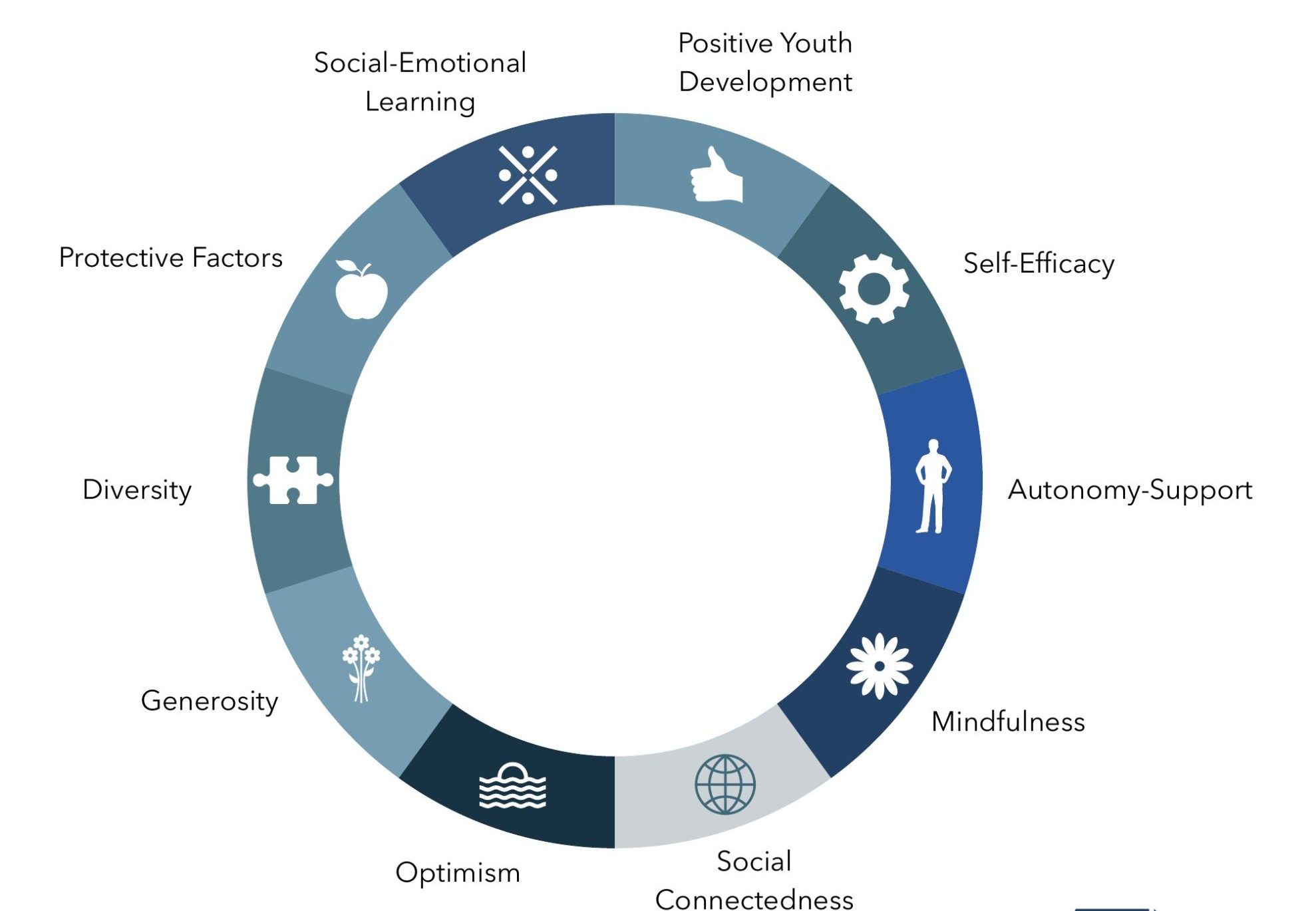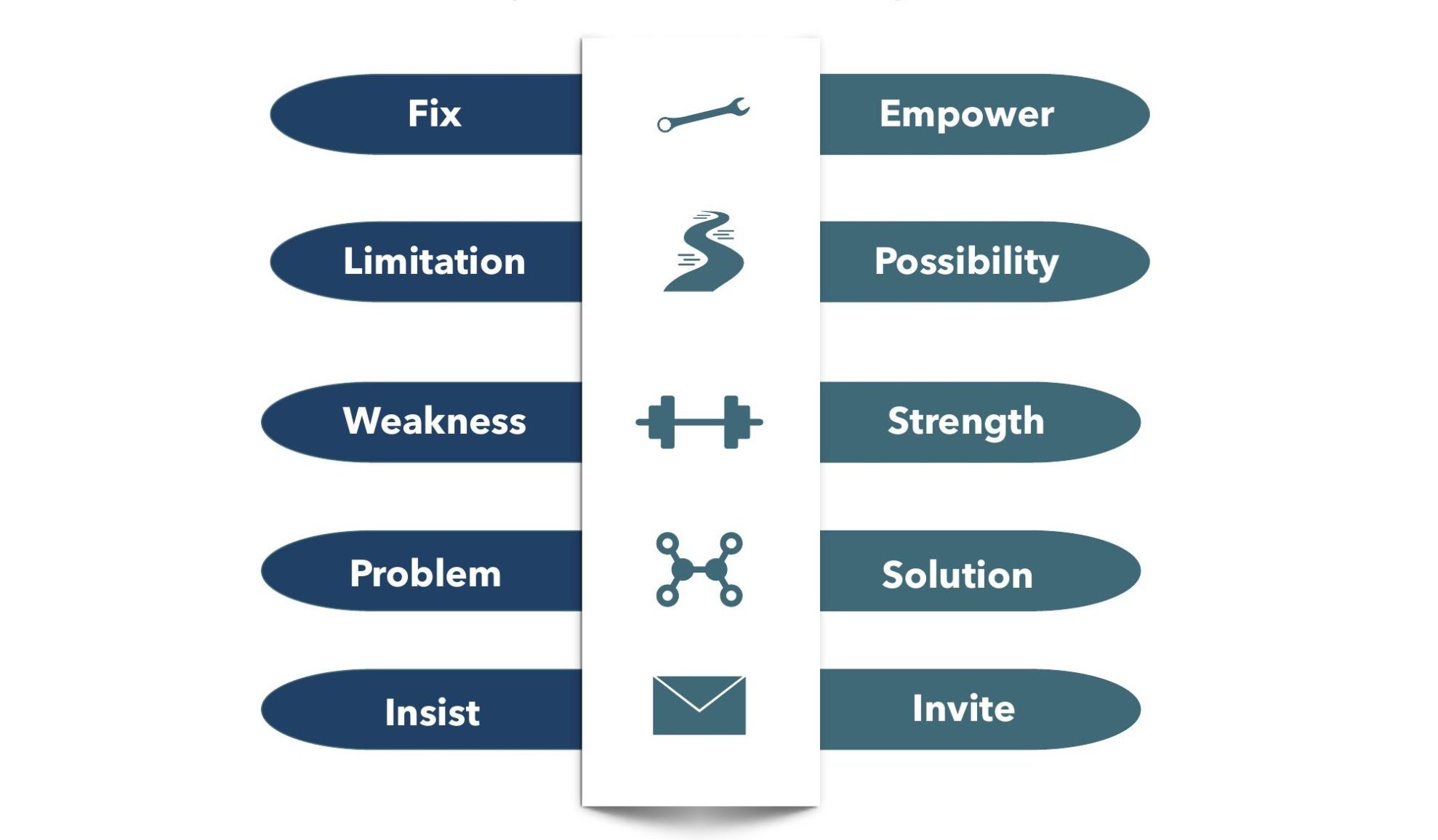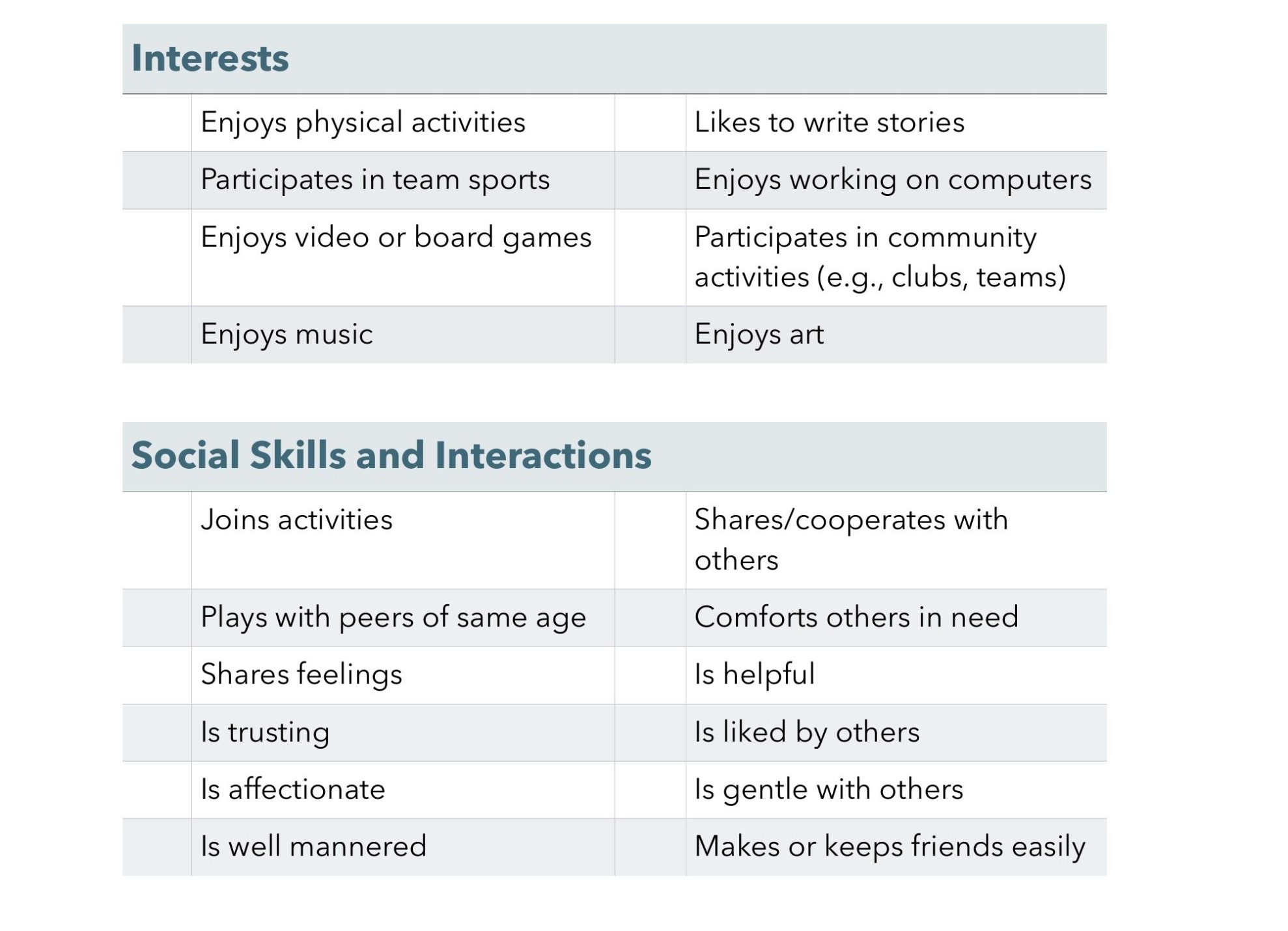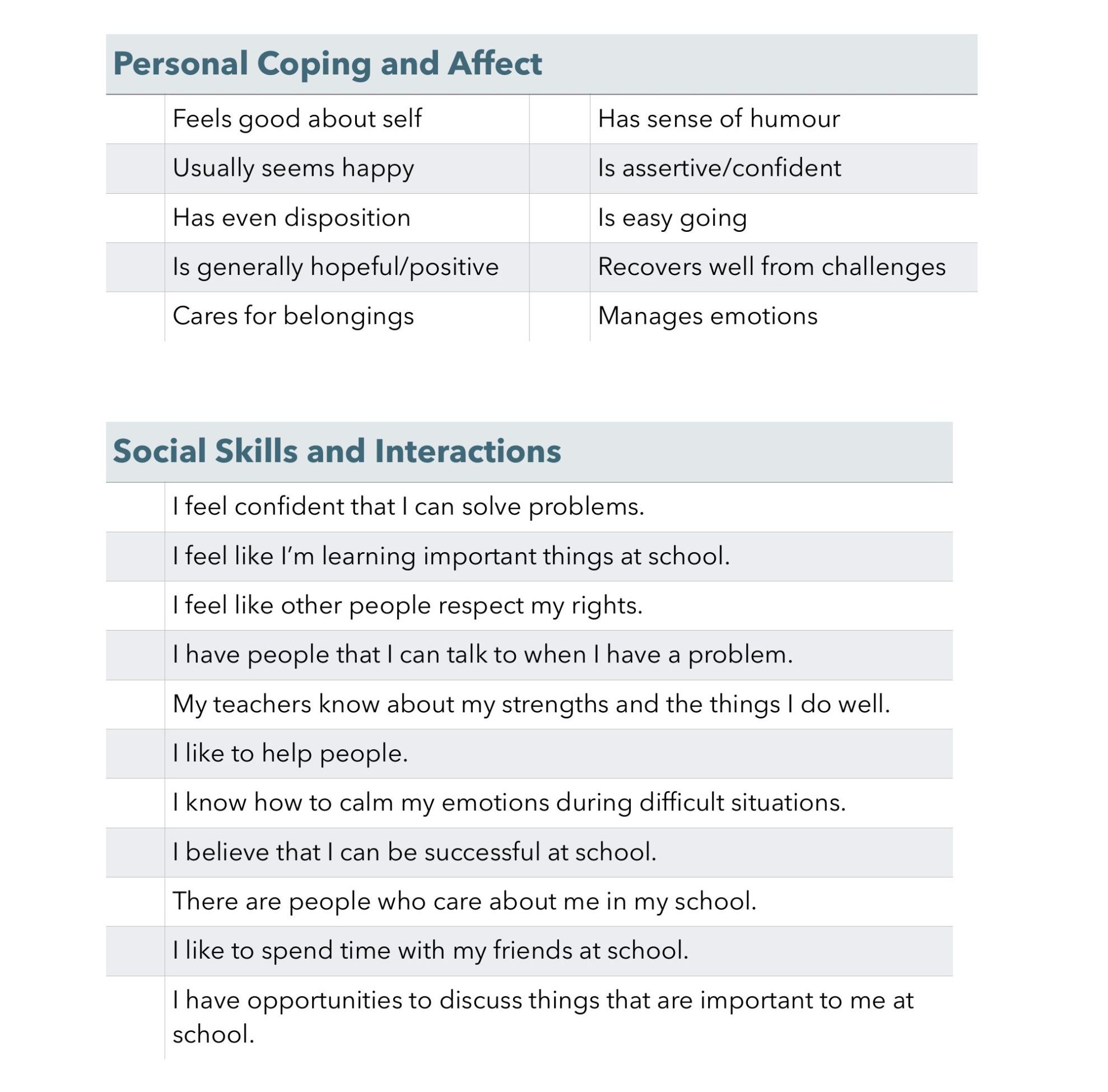Module Overview
Module 3: Engaging Student Strengths highlights ways to incorporate strength perspectives while teaching and learning in a health-promoting school environment. Content includes perspectives, practices, assumptions and approaches for applying strength-focused practices in all aspects of the teaching and learning environment.
Objectives of this module are:
- To understand the benefits associated with embracing a positive view of students and their potential
- To become familiar with strength-focused concepts and approaches
- To explore the characteristics of strength-focused school cultures
- To consider ways to identify student strengths and interests
Strength Perspectives and Practices
Past approaches to addressing student well-being in educational settings have focused primarily on the identification of:
- Learning challenges
- Risk-need factors
- Targeted academic or social-emotional interventions
Traditionally, such approaches have emphasized the problems or challenges associated with existing or emerging concerns, and the approaches or interventions needed to address areas of risk and need.
A Positive View of Students and their Potential
In addition to providing timely access to resources and supports, positive mental health research has demonstrated the importance of moving beyond a problem-focused approach to embrace a more positive view of students and their potential. The emergence of positive psychology approaches has contributed to an increased focus on the identification, exploration and use of strengths in children and youth to foster positive mental health outcomes.
Understanding Your Biases
It is important for all educators to be introspective about their own potential biases and stereotypical assumptions related to individual strengths, and to understand that strengths may be perceived differently among various cultures, races or gender-based communities.
In British Columbia, the Integrated Child and Youth (ICY) Provincial Support Office recommends that teachers and administrators practice reflect on the role that biases may play in designing and delivering strength-based supports for students, suggesting that:
“Cultural humility and reflexive practice involve becoming aware of and reflecting on internal biases, whether they be conscious and/or unconscious. In many cases, we are not aware of our pre-conceived beliefs until we encounter someone who holds different beliefs.”
Questions to support personal reflection may include:
- Can you think of a time when you realized someone held different fundamental beliefs or values from you? If possible, think about a situation where you were interacting with someone from a cultural background different than your own.
- How did you learn about this difference in values or beliefs?
- How did this learning impact your behaviour?
BC ICY Provincial Support Office, 2023
Enhancing Positive Qualities
Over the past decades, the emergence of strength perspectives and practices has shifted the focus of educators from a singular focus on improving learning deficits to an enhancement of existing or emerging positive qualities. Such qualities or factors may include the exploration of:
- Positive traits
- Personal preferences and interests
- Demonstrated strengths or potential
- Experienced success or accomplishments
- Positive personal experiences and relationships
- Engagement in initiatives/programs that enhance the quality of life
The promotion of strength perspectives and practices has increased emphasis on prevention and ecological approaches that contribute to positive development and well-being. This, in turn, has reinforced the importance of universal strategies for supporting the social emotional development of all children and youth, including those with and without identified mental health concerns.
Positive Mental Health
Strength-oriented perspectives and practices have been referred to as positive mental health approaches, placing emphasis on the positive aspects of personal or collective well-being. This term underscores that well-being is more than the absence of mental health concerns and involves the promotion of vitality and thriving in students. Schools play an essential role in promoting mental well-being in children and youth. For some students, the provision of positive environments at school and opportunities for them to take part in activities that promote their well-being will represent an important protective factor that may not be present in other aspects of their lives. According to the Canadian Mental Health Association (2024), schools can promote positive mental health by:
- Promoting active living (health and physical education classes, sports teams and intramural activities)
- Teaching children and youth about healthy eating
- Teaching coping skills, such as self-awareness and stress management
- Promoting positive self-esteem
- Creating an open environment for talking about their problems and questions
- Providing spaces for relaxation, such as a lounge and quiet corners within classrooms
- Implementing and actively supporting policies for safe and accepting schools, including bullying prevention and intervention policies
Strength-focused Concepts
Research and professional literature focusing on strengths encompasses a wide array of key concepts that describe the nature and characteristics of promising perspectives and practices for the promotion of psychological well-being among children and youth.
Strength-focused Language
- Strength-focused language may be used to reframe and restate problem-oriented statements to emphasize opportunities for positive actions and to focus on strengths. For example:
- Problem-focused: “She has problematic behaviours.”
- Strength-focused: “She’s determined to survive and cope, and right now her behaviour is part of what she’s using to do that.”
Strength-based Principles
The following highlights a series of principles that are essential for incorporating strength-based perspectives within our approaches and interventions in working with students and their families.
| Believe in People | Embracing strength-based perspectives requires a belief that every student has innate strengths, capacities and potential. |
| Engage People | Applying strength-based perspectives involves engaging students, hearing their voices, supporting their autonomy, and inviting their collaboration in pursuing positive change. |
| Incorporate Sources of Motivation | Strength-based approaches incorporate themes and content that engage students’ interests, motivations and passions. |
| Use Strength-focused Language | Strength-based approaches use language that promotes potential, hope and optimism, even in the midst of difficult circumstances. Challenges are reframed as opportunities for positive change, growth and development. |
| Begin with existing strengths | Strength-based approaches focus on what students can do as a starting point. Challenges are interpreted as opportunities to explore potential options. Small-step successes provide the foundation upon which hope and optimism are built. |
| Build Authentic Relationships | Strength-based approaches recognize that positive change occurs in the context of authentic relationships within educational settings. Students need to know that they are included, cared about and supported. |
| Allow Time for Change | Strength-based approaches recognize that positive change takes time. Steps in moving toward positive change include being aware of the benefits of specific directions for change, building capacity through skill development and increasing self-efficacy. |
Strength-based School Cultures
School leadership sets the tone for cultures that reflect strength-based principles and practices. Sustaining school-wide strength-based approaches requires active modelling of perspectives and practices: “It is about having a strength-based way of thinking, describing and practicing that is consistent and purposefully supported by all staff and supporting community volunteers” (Alberta Mentoring Partnership, nd, p. 6).
Strength-based school cultures:
- Practice a philosophy based on values and guiding principles for working with all students to bring about change
- Engage students in relational ways that demonstrate positive attitudes about their dignity, capacities, rights, uniqueness and commonalities
- Create conditions and unique opportunities that enable teachers and students to identify, value and draw upon their strengths and capacity in ways that create meaningful and sustainable progression towards change and goals
- Provide and mobilize resources in ways that complement a student’s existing strengths and resources as opposed to compensating for perceived deficits
- Acknowledge and address power imbalances between students and adults
- Seek to identify and address social, personal, cultural and structural constraints to a student’s desired goals, growth and self-determination (Adapted from Alberta Mentoring Partnership, nd, p. 6).
Neurodiversity: A Strength-based Approach
Neurodiversity describes a spectrum of neurological differences, representing natural variations in the way students perceive and experience the world. For some students, these differences are recognized as neurological conditions such as Autism Spectrum Disorder (ASD), Attention Deficit Hyperactivity Disorder (ADHD), specific learning disabilities or intellectual disability, among others.
“The concept of neurodiversity embodies a strengths-based model that shifts the focus away from the challenges of students with neurological differences in favour of finding ways to work with the strengths of the student to enable them to participate and experience educational success. In this model, the strengths and interests of the student are the starting point for curriculum design, teacher pedagogy, and the design of the learning environment”
(The Education Hub, 2019, p. 2).
Implications for cognition
Adopting strategies that support neurodiversity in the classroom is a universal practice that benefits all learners. Specific strategies have been identified (The Education Hub, 2019) that support the learning needs of students related to information processing, memory and organization.
- Have a clear outline and learning objective for each lesson and communicate this to your class both verbally and visually
- End each lesson by reviewing the learning objective and allow students to evaluate their own progress
- Have shorter fast paced and interactive learning activities for students who are active in body and mind
- Be flexible about the time you allocate to completing a task for students who require longer processing time or worry about getting things right
- Use colour coding to organize information
- Use a clear sans serif font that is 12pt or above and black or blue markers that are easy for students to read (p. 3)
Social and emotional needs
Some students with neurodiversity may need support with their social interactions or social/emotional needs. Others simply require our deeper understanding of their communication style or individual preferences related to social interactions. To provide universal supports in the classroom and school that embrace neurodiversity while still creating environments that support social/emotional growth and development, adopting the following strategies may be helpful.
- Encourage and facilitate positive social interaction between learners, while allowing for various communication styles and preferences.
- Consider letting students choose whom they sit next to or with whom they engage in group work.
- Implement a buddy system for students who require prolonged social support.
- Provide opportunities for students to practice positive social skills
- Provide safe opportunities for students to request help.
- Provide exemplars of work that is not perfect to encourage trying.
- Be aware of signs that may indicate a student is becoming overwhelmed and respond with reassurance and compassion (Adapted from The Education Hub, 2019).
Physical learning spaces
Physical learning spaces can be adapted to meet the needs of diverse learners through the layout of classroom furniture, labelling the environment and resources, and adjusting the proximity of seating to other students or windows and doors which may provide distractions.
Classroom environments should be clear visually and in physical layout to help diverse learners navigate movement from one area to the next. For example, you can colour code and label different areas of the classroom and match colours and labels to resources intended for use in those areas. You may also want to consider providing choice for where students work (p. 4).
Exploring Student Strengths
An essential component of effective teaching is gaining an understanding of students’ strengths and interests. Engagement is fostered when students believe that teachers and others in the school are aware of their strengths, and use them in the creation of meaningful teaching and learning processes.
Scheduling time throughout the school year to spend with students individually to hold discussions on strengths and interests can increase students’ sense of competency and engagement in their own learning journeys. Using an informal interview guide can focus these discussions, and encourage students to share about the things that are important to them. Responses can lead to more effective engagement efforts and the design and delivery of meaningful supports and interventions.
The following interview guide is an example of an informal strength and interest inventory used by Resource Specialists in Assessment and Intervention in New Brunswick schools that can assist with developing a holistic overview of students’ personal qualities, strengths and capacities.
Please review the list of interests and strengths below, and following initial meetings or observations, place checks beside all that apply. You may add notes to the form to expand upon your discussions with or observations of the student. Not all items in Part 1 and Part 2 will be relevant to individual student circumstances, and others can be added based on what you learn about the student.
Part 1: Strength and Interest Checklists
Part 2: Sample Strength-based Discussion Items
- What is your favourite class or activity in school and why?
- Which school subject do you enjoy the most? Why do you think that is so?
- Give an example of a classroom activity where you felt you really learned a lot. What did you find most interesting about that activity?
- Do you prefer to work alone or in groups? Why?
- What type of job do you think you’d like to do when you grow up / after high school?
- Besides hanging out with friends, what do you like to do in your spare time?
- How many hours a day do you use a computer, tablet or phone? Besides school work, what types of things do you use technology for?
- Do you belong to any clubs or teams, either in school or outside of school?
- Describe your favourite thing(s) about yourself.
- Do you like to read? What are your favourite things to read?
- Tell me about your favourite movie or show and why you like it.
- If you could travel anywhere in the world, where would it be and why?
- Tell me about a past accomplishment that made you feel proud of yourself.
- Is there anything else you want me to know about you?
Strategies for Building Student Strengths in the Classroom
The following strategies encourage the development of a sense of competency in the classroom and at school. These activities can easily be adapted according to the age and level of development of the student:
- Invite students to personalize their workspaces to reflect their preferences, interests and strengths. Encourage students to share the meaning behind personal items in these spaces in order to enhance opportunities for positive and strength-focused interactions in the classroom.
- Before teaching a new topic or skill, invite students to share about their prior knowledge of the subject area. Display a list of all the prior learning highlighted by students and refer to the list during lectures and class discussions. Linking new learning to prior knowledge values the experiences and contributions of students.
- When assigning group work, ask students to track and report on examples of the strengths or abilities of their team members in contributing to the activity.
- Facilitate a discussion about creating a positive culture in the classroom using students’ strengths. As a result of this discussion, identify two or three projects or learning activities to engage students in using their strengths to contribute to the positive environment of the classroom.
- Encourage students to think of another student or adult who has contributed to their learning. What are the strengths and positive characteristics of the person who helped or supported them? Organize a “Thank You” activity to recognize this person (e.g., a note, a drawing, a poem).
- Look for slogans or short, positive sentences that affirm or encourage the use of strengths, talents and creativity. Post these phrases or slogans in classrooms, hallways or elsewhere in the school. Each week, post new slogans or phrases to keep them updated and interesting.
Strategies for Building Student Strengths in the Home
Using competency strategies at home encourages positive interactions and conversations between students and their parents / caretakers and other family members. These conversations contribute to parents’ knowledge of their child’s involvement in school routines and activities.
- Invite students to share an achievement or skill related to their learning with their parents or other family members. As a follow up, provide time in class for students to share how the discussion went.
- At different points throughout the year, invite family members to come to the classroom to share their passions, interests or hobbies.
- Create a class newsletter that includes stories on the strengths and achievements of students. Students should serve as writers, photographers and artists for the newsletter, which could be distributed to home and school two to three times a year.
Strategies for Building Student Strengths in the Community
Generosity includes actions that contribute to the quality of life of others without necessarily receiving something in return. In relation to competency, generosity can involve strategies to recognize, validate and appreciate the strengths or contributions of others, not only at school but also in the community.
- Lead a class discussion about the people who contribute to the quality of life of others in the community. Think about people who may not have been recognized for their efforts, and identify activities to recognize them and express appreciation for them.
- Each community is made up of people with different cultures and backgrounds. Demonstrate appreciation for diversity by inviting community members to share their stories in the classroom.
Digging Deeper
- Strengths-based teaching and learning approaches for children: Perceptions and practices
- Creating strength-based classroom and schools: A practice guide for classrooms and schools
- A renewed focus on strengths-based assessment in schools
- References



